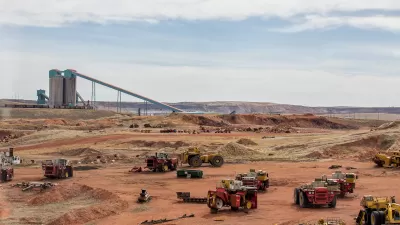No, this post is not about the Russia investigation nor #MeToo, but the state of climate policy in the U.S. after President Trump's first year. Surprisingly, it's not as bad as one might think, no thanks to Trump though.
James Brasuell's blog post on President Trump's State of the Union address on Tuesday dealt many aspects of urban planning, including infrastructure, immigration reform, and dismantling the federal bureaucracy.
Brad Plumer, a reporter on The New York Times's climate team, wrote the first piece for Wednesday's "Climate Fwd:" newsletter, on what an "update on the state of American climate policy after one year of the Trump administration...would it look like."
Yes, Trump has clearly been successful in undoing much of his predecessor's accomplishments on climate policy, including dismantling the clean power plan and withdrawing from the Paris climate agreement, making a clear case for "American Alone" despite his claims to the contrary at the World Economic Forum in Davos on Jan. 26.
See the Times' updated deregulation tracker for the full list, and many here on Planetizen.
But here's the good news for those who believe climate change isn't a hoax.
Mr. Trump hasn’t been able to halt many of the most important trends around the country toward lower emissions. Plenty of states, like California and New York, are still pressing ahead with their own local climate policies. The coal industry, responsible for a quarter of the nation’s emissions, continues to shrink, edged out of the energy market by less expensive natural gas despite Mr. Trump’s efforts to save it.
On top of that, the cost of wind and solar continues to drop rapidly as technology advances. Even after Mr. Trump’s recent tariffs on solar imports, more utilities are turning to renewable energy as the lowest-cost source of new power. Electric vehicles are making inroads. Other countries are still crafting an international climate treaty without the United States.
More good news — U.S. energy-related carbon dioxide emissions fell last year, but the bad news is that this year they will rise, according to the Energy Information Administration.
It’s fair to say that those two broad dynamics — the Trump administration’s regulatory rollbacks and the stubborn march of clean energy — have fought each other to a standstill.
Sadly, this post ends on a pessimistic note. Plumer warns us that "we’ve reached the point on climate change where a holding pattern is no longer sufficient to give us a decent shot at stabilizing global temperatures this century and avoiding irreversible changes to Earth’s weather patterns."
That’s what makes climate change unlike other policy issues. There’s an unforgiving timeline dictated by physics, and the rate of change matters as much as the direction. In that context, even a temporary impasse can be hugely consequential.
FULL STORY: The State of the Climate, One Year Into the Trump Era

Alabama: Trump Terminates Settlements for Black Communities Harmed By Raw Sewage
Trump deemed the landmark civil rights agreement “illegal DEI and environmental justice policy.”

Study: Maui’s Plan to Convert Vacation Rentals to Long-Term Housing Could Cause Nearly $1 Billion Economic Loss
The plan would reduce visitor accommodation by 25% resulting in 1,900 jobs lost.

Why Should We Subsidize Public Transportation?
Many public transit agencies face financial stress due to rising costs, declining fare revenue, and declining subsidies. Transit advocates must provide a strong business case for increasing public transit funding.

Wind Energy on the Rise Despite Federal Policy Reversal
The Trump administration is revoking federal support for renewable energy, but demand for new projects continues unabated.

Passengers Flock to Caltrain After Electrification
The new electric trains are running faster and more reliably, leading to strong ridership growth on the Bay Area rail system.

Texas Churches Rally Behind ‘Yes in God’s Back Yard’ Legislation
Religious leaders want the state to reduce zoning regulations to streamline leasing church-owned land to housing developers.
Urban Design for Planners 1: Software Tools
This six-course series explores essential urban design concepts using open source software and equips planners with the tools they need to participate fully in the urban design process.
Planning for Universal Design
Learn the tools for implementing Universal Design in planning regulations.
Caltrans
Smith Gee Studio
Institute for Housing and Urban Development Studies (IHS)
City of Grandview
Harvard GSD Executive Education
Toledo-Lucas County Plan Commissions
Salt Lake City
NYU Wagner Graduate School of Public Service





























